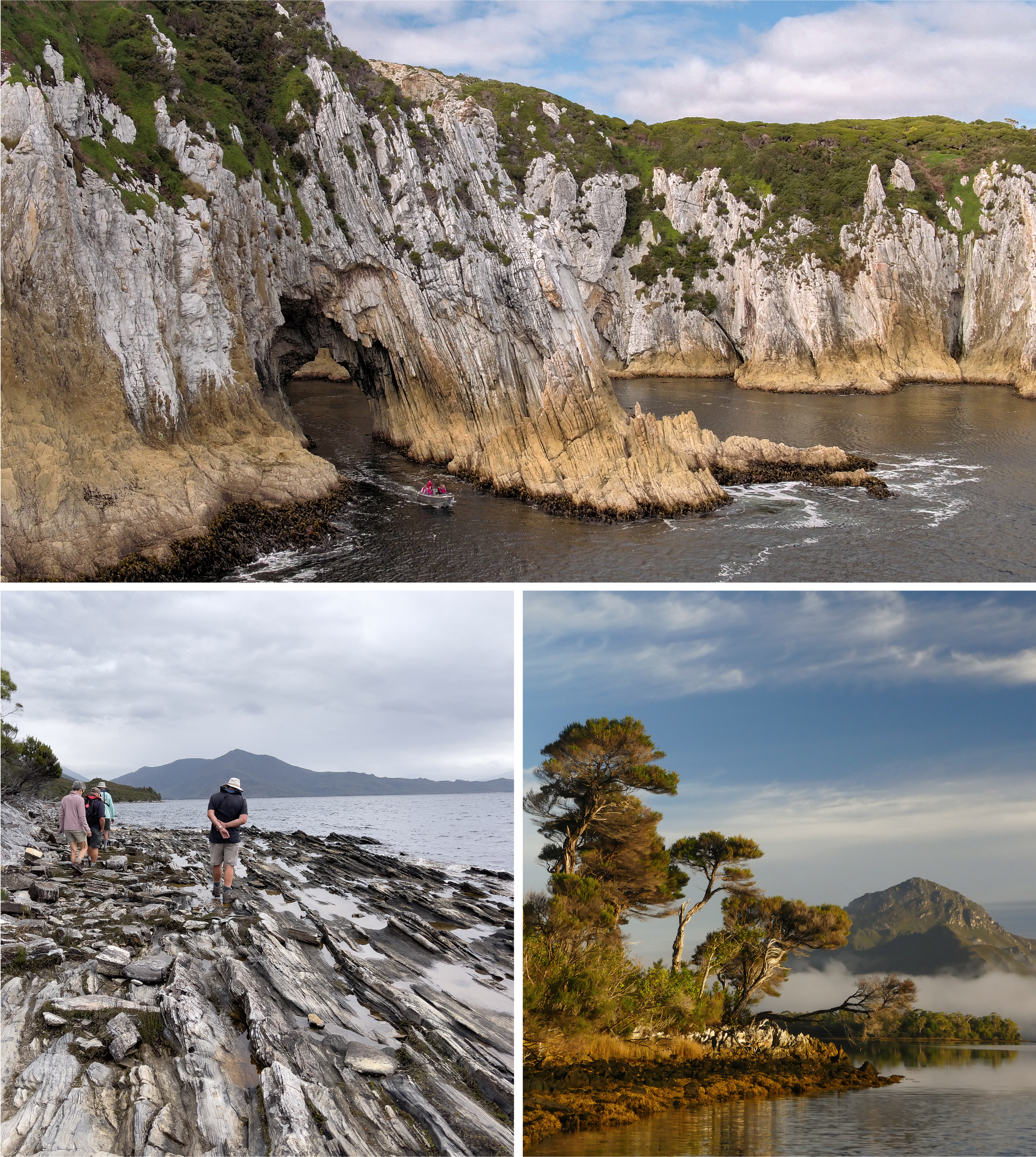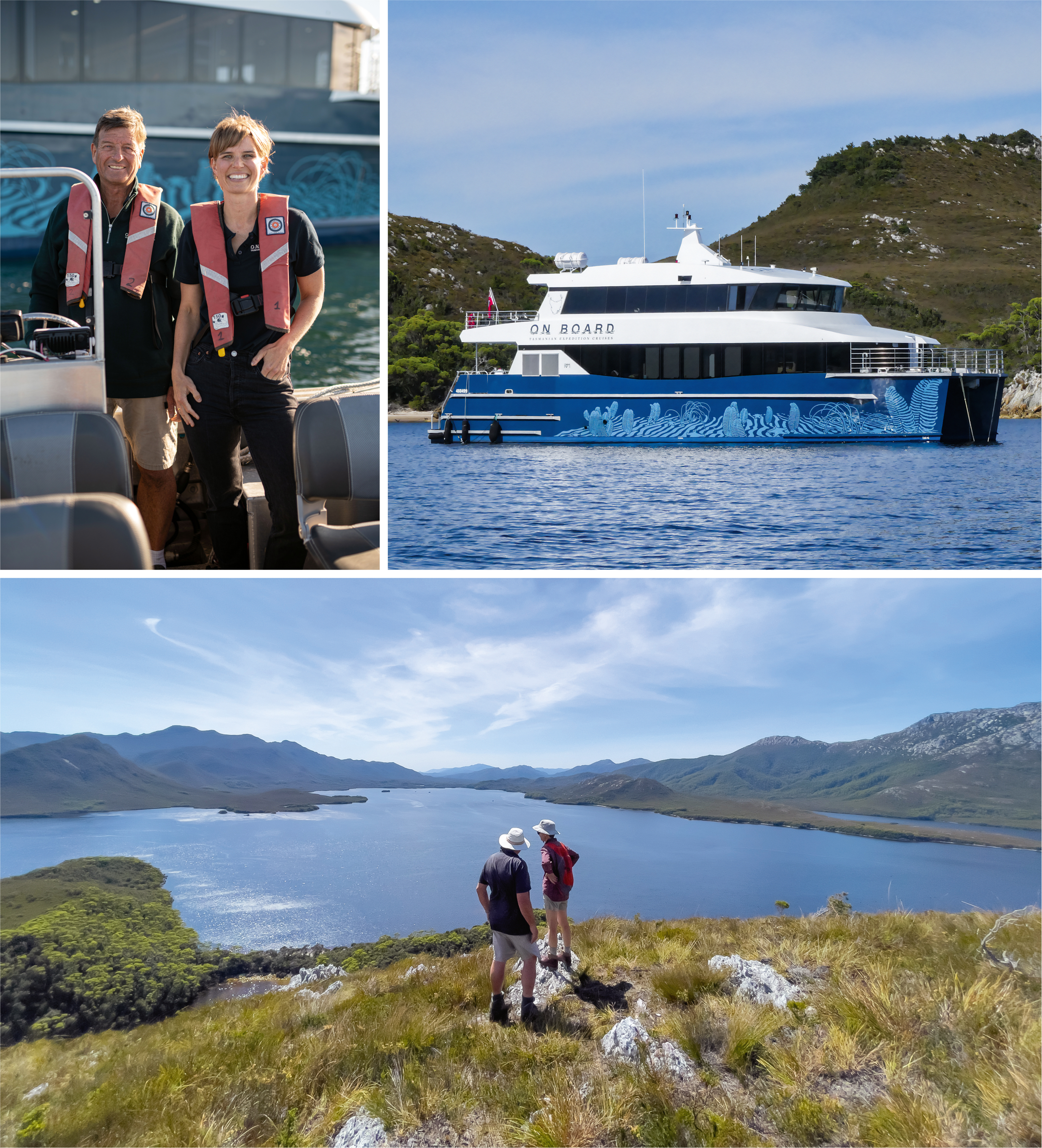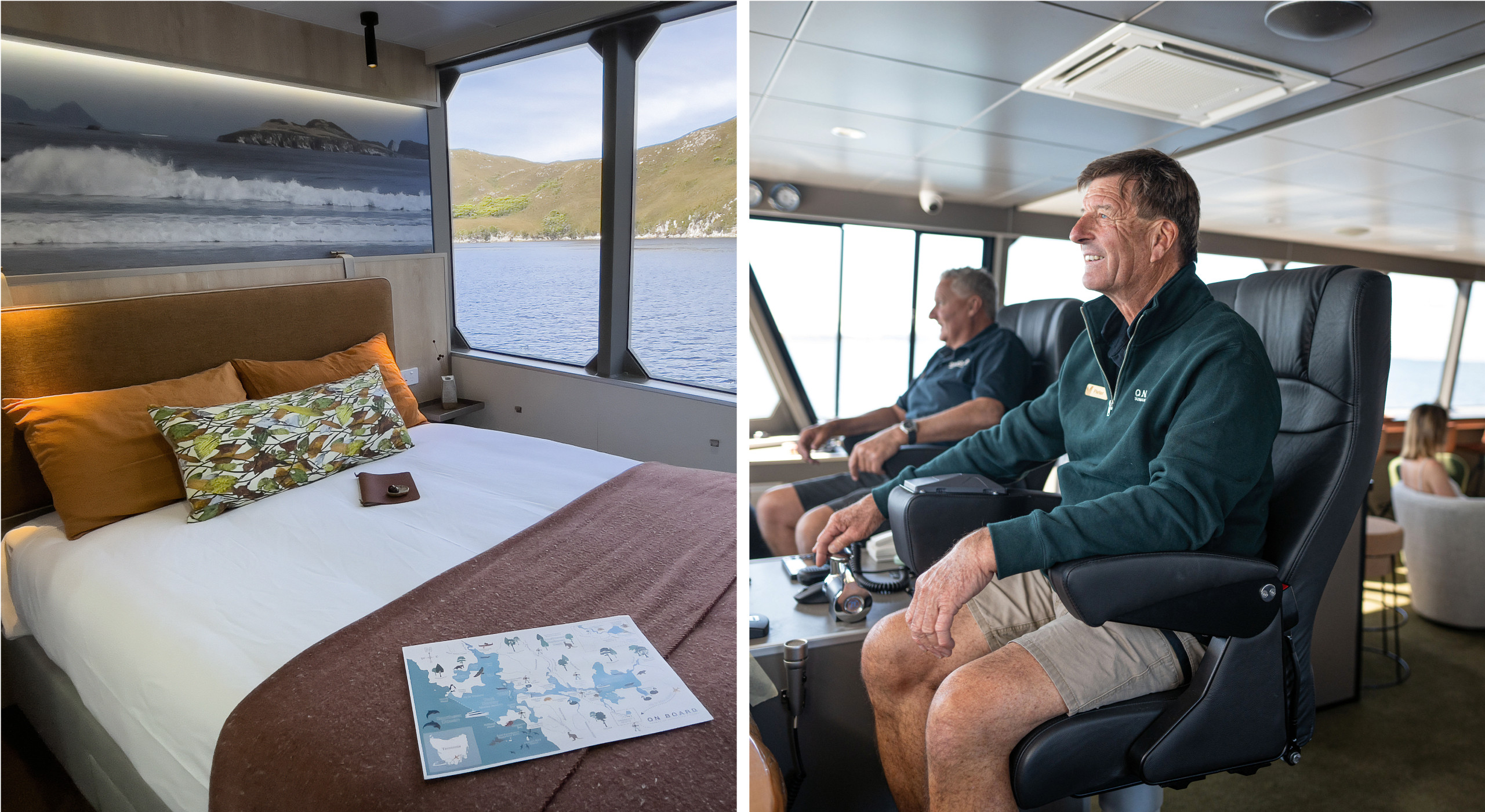
Wilderness waterway
An intimate expedition vessel offers unrivalled access to Port Davey in Tasmania’s wild and remote south-west.
STORY + PHOTOS BRIAR JENSEN | OUTBACK MAGAZINE
Mid-morning sun glints off porcelain-white quartzite cliffs on Breaksea Islands in Port Davey, within Southwest National Park, Tas. Jagged rocks jut skywards like vertical razor blades, their fractured edges mimicking city skylines.
Fleshy bull kelp sways with the swell as owner-skipper Pieter van der Woude aligns Odalisque’s tender with a crack in the cliffs, guns it between swells and glides into a cave.
Rock walls centimetres either side of the tender plunge into water so clear you can see crayfish clinging to crags like red bakelite brooches. It’s unexpectedly quiet, just sea sloshing against rock and hull. Scooting out the end into the Southern Ocean, normally reserved Pieter whoops with excitement. “You guys are so lucky,” he says. “We only get to do this 4 or 5 times a year.”
Days earlier surging 3m swells smashed into the Breakseas, hence their name, sending whitewater frothing skyward and flinging bull kelp like hula skirts. Even today’s minimal swell powers a blowhole that explodes like rogue fireworks. Still, it’s hard to imagine the mammoth waves that sometimes crash over a 12m cliff defoliating it of native pigface and poa grass.

That’s the drama of the south-west, where the weather can be as temperamental as a teenager. But whether it’s saturated in sunshine, moody and monochrome, or wet and wild, it’s always cinematically stunning. Guest Steph Ball, farmer and photography enthusiast from Warooka, SA, agrees. “Cruising the still waters of the harbour, the wild ocean and the rugged scenery of Port Davey is indeed a special experience,” she says.
“We tailor experiences to what the weather lets us do,” Pieter says of the 4- and 6-night cruises aboard boutique expedition vessel Odalisque III, which is based in Port Davey from January to May, with guests flying in by light plane from Hobart (soon to be seaplane). It’s a challenging location for a charter business, but Pieter’s in his element.
A former policeman, search-and-rescue diver, abalone fisherman and tender driver for the Australian Antarctic Division, he knows the area intimately and developed the charters with his daughter Alice in 2016 to share the region’s wild beauty with nature-loving guests. “I don’t need to do it,” he says, “But I love doing it.”

CLOCKWISE FROM TOP: Guests explore a sea cave at the Breaksea Islands; trees on Celery Top Islands, which have never experienced fire, resemble bonsais; rock shelf near the Old River. Deny King used this softer quartzite for chimneys;
Odalisque III, launched in 2023, is a purpose-designed 24m catamaran built in Hobart. Six tastefully appointed ensuite cabins cater for a maximum of 12 guests. In the lounge adjacent to the open helm station, where Pieter welcomes a chat, it feels like travelling on a mate’s luxury boat, as guests recount the day’s adventures over pre-dinner tipples before a feast of Tassie’s finest produce prepared by chef Courtney Drew.
Three times the size of Sydney Harbour, Port Davey offers unrivalled access to the flora and fauna of Southwest National Park, the southernmost section of the 15,800sq km Tasmanian Wilderness World Heritage Area. “It’s remained much the same for a long time,” says guide Peter Mooney, previously general manager of Tasmania Parks & Wildlife Service. There are no roads: access is by boat, light plane or a 6–8-day walk.
Peter’s expertise enhances hikes through button grass, flowering tea-tree and banksia to the top of Balmoral Hill for 360-degree views of Bathurst Channel, its bays, inlets and creeks seeping into the surrounding rugged ranges. He points out burrowing crayfish holes beside the track as white-bellied sea eagles soar past at eye level.
“It’s such a fascinating place geologically,” says hostess Bridget ‘BJ’ Jupe, whose science background includes botany, geography and environmental education.

CLOCKWISE FROM TOP: Pieter van der Woude and his daughter Alice; Odalisque III is based in Port Davey from January to May; Guests overlook Bathurst Channel from Balmoral Hill.
A drowned river valley, Port Davey resembles a gaping jaw, the Breaksea Islands like tonsils protecting the narrow throat of Bathurst Channel. Here, dark, tannin-stained, nutrient-poor freshwater sits atop the saltwater, restricting light, and allowing deepwater marine invertebrates to grow in much shallower water, such as delicate feather-like sea pens. “It’s a very fragile place,” Pieter says.
The original inhabitants of the land on what is now protected by Port Davey Marine Reserve were the Needwonnee people and at Melaleuca Lagoon an interpretive boardwalk tells their story against a mirrored backdrop of mountains reflected in inky, reed-fringed water. A few hardy whalers, Huon piners, fishermen and miners ventured here, but only 3 families stayed, the Kings, Claytons and Wilsons.
Tin miner Deny King lived here until his death in 1991. The biography King of the Wilderness, by Christobel Mattingley, is a fascinating insight into the miner, artist and environmentalist, whose meticulous observations of weather, flora and fauna highlighted new species and the decline of others, such as the orange-bellied parrot.

An Odalisque tender squeezes through kelp-lined caves in the Breaksea Islands.
A small museum at Melaleuca, named after Deny, doubles as a volunteer monitoring station for the now critically endangered parrots. It’s thrilling to see several flit about the feeding station. On a tour of Deny’s garden and Nissan huts he built for hikers, Pieter tells how Deny singlehandedly built the quartzite airstrip still used today. Deny’s sister married fisherman Clyde Clayton and their cottage at Claytons Corner, maintained by volunteers, includes storyboards of their life.
Puttering in tenders up narrow Davey Gorge, the landscape squeezes in. Creeks of whiskey-coloured water, iced by white quartzite rocks, are garnished with mossy-green marsupial lawns and swizzled by bleached tea-tree trunks. Keen-eyed guests spot an azure kingfisher.
In contrast, walking from protected Spain Bay across the peninsula to Stephens Beach, the landscape unfurls into the Southern Ocean. Pieter points out Aboriginal middens that rise like dunes around a freshwater creek, hundreds, possibly thousands of years old. “This place has an aura about it,” Pieter says reverently.

Pieter van der Woude at the helm, near the guest lounge.
As guests picnic on the beach or brave an ocean swim, Pieter dons rubber gloves, snorkel and flippers and dives in search of crayfish. He finds several, but they are unfortunately undersized. There is fresh tuna for sashimi though, after trolling to East Pyramid Islands, where fur seals frolic in the kelp and haul out on rocks beneath thousands of swirling, squawking gulls.
Pre-cruise, Sue Robinson and Simon Foote, keen walkers who own a conservation property in Dover, Tas, had contemplated hiking the 85km South Coast Track, but Sue says the cruise covers much more. “You see a lot of areas you wouldn’t see walking here,” she says. “It’s been stunning.” Even with the premium price tag, Sue says, “We’d definitely do it again”.
After a week of sunshine, departure flights are delayed 24 hours due to inclement weather. Clouds roll down the ranges like icing down the sides of a cake. Drizzle diffuses the light, smudges mountain ranges and water colours the landscape pumice, pewter, gunmetal and graphite.
Guests don rain ponchos for a tender jaunt in Joe Page Bay, where several hundred black swans take flight, white wingtips winking an aerial morse code. At the Celery Top Islands in Bathurst Harbour wind-sculpted trees resembling bonsais in quartz bowls emit the soulful beauty captured by artist Jennifer Riddle in her 2022 Glover prizewinning painting Wanderings of the Past and Now hanging in Hobart’s Henry Jones Art Hotel. “I’m glad you saw it like this,” Pieter says.